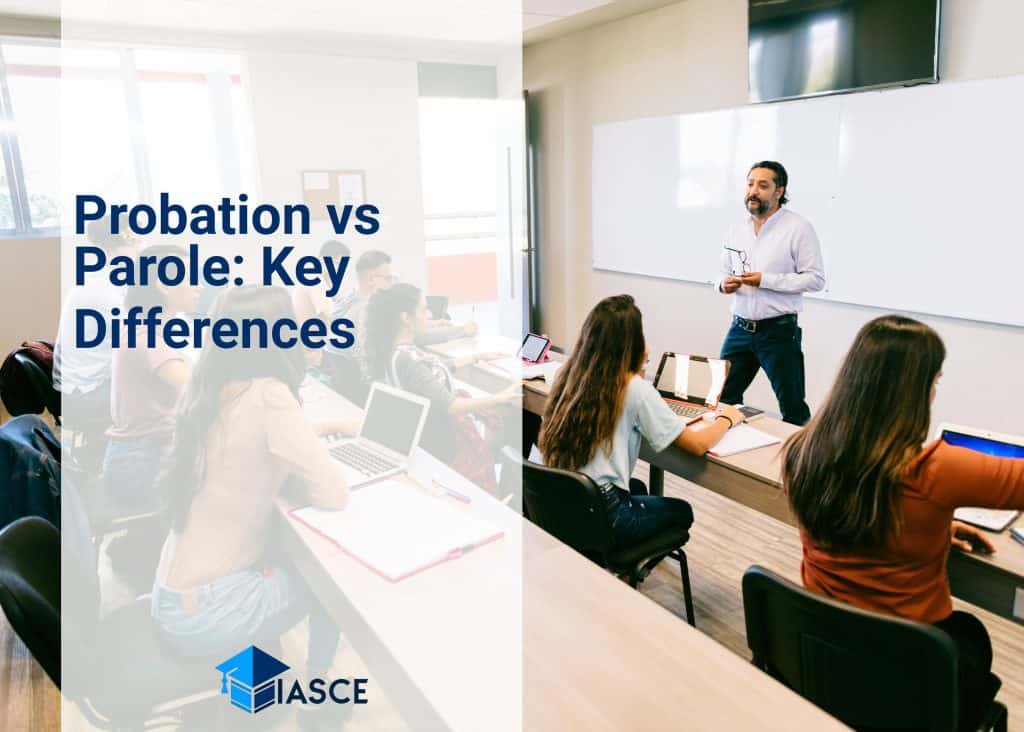Many often confuse the terms probation and parole, and it’s easy to see why. On the surface, they appear similar. Both are alternatives to incarceration that allow individuals to live in the community under supervision. However, they’re not interchangeable.
Diving a bit deeper, I’ll unravel these legal concepts for you today. Probation is a type of criminal sentence allowing a person to stay in the community rather than serving time in prison, provided they follow certain conditions. Parole, on the other hand, involves conditional early release from prison.
By understanding the definitive distinction between probation and parole, we can better navigate conversations around our justice system. Let’s delve into this topic further…
Let’s dive right into the core of our topic: probation. We often hear the term thrown around in legal discussions, but what does it truly mean? In essence, probation is a type of criminal sentence that allows a person to stay in their community instead of serving time in prison, as long as they comply with certain conditions.
The concept behind this form of punishment is rehabilitation over retribution. It’s believed that individuals can better mend their ways by remaining part of society under supervised guidance. This way, they’re offered an opportunity to demonstrate good behavior without incarceration’s harsh environment.
Now you might be wondering who decides these ‘conditions’ and how strictly are they enforced? Enter the stage – Probation Officers! These officials supervise offenders on probation ensuring that all conditions set by the court are being adhered to. These could range from regular meetings with probation officers, mandatory employment or education requirements, curfews, drug tests and more.
But let me state clearly – Probation isn’t a ‘get out of jail free’ card. Violating any condition can lead to severe consequences including revocation of the probation order and immediate imprisonment.
To give you some perspective on its prevalence – according to Bureau of Justice Statistics data from 2018:
| 2018 | 3,540,000 |
That’s quite a significant number! And it holds testament to our legal system’s trust in this formative method over punitive measures like imprisonment.
So there you have it – A snapshot into what probation really entails within our justice system!
| Word | Example | Context |
|---|---|---|
| Probation | John was sentenced to two years of probation for his minor offense. | “Probation” refers to a period of supervision in the community for a convicted offender as an alternative to incarceration. It’s typically determined by a judge at the time of sentencing. |
| Parole | After serving ten years in prison, Mark was released on parole. | “Parole” is the supervised early release of a prison inmate before the completion of their sentence. It’s usually granted by a parole board after a portion of the sentence has been served. |
| Probation | Violation of the conditions of her probation resulted in her being sent to jail. | “Probation” is a sentence ordered by a court where a defendant is allowed to remain in the community under the supervision of a probation officer. |
| Parole | He was granted parole based on his good behavior in prison. | “Parole” is a period of conditional supervised release in the community following a prison term. It’s granted based on the inmate’s conduct, nature of the offense, and likelihood of becoming law-abiding. |
| Probation | He served his probation without any violations and has since been discharged. | “Probation” is often used for first-time or minor offenders, where the person can serve their sentence within the community under specific restrictions and supervision. |
| Parole | The parole board denied his request for early release. | “Parole” involves the release of an inmate before the completion of their maximum sentence with a period of supervision to follow. |
| Probation | As part of his probation, he had to attend regular meetings with his probation officer. | “Probation” serves as a punishment for an offense committed, but allows the person to live in their community under the supervision of a probation officer. |
| Parole | His parole requires him to meet regularly with his parole officer and adhere to strict guidelines. | “Parole” allows a person to serve the remainder of their prison term in the community under the supervision of a parole officer and specific conditions. |
| Probation | His probation terms include regular drug testing and community service. | “Probation” involves conditions set by a court that must be followed by the convicted individual while living in their community. |
| Parole | Violating the terms of his parole could send him back to prison. | “Parole” is granted with certain terms and conditions, and violation of these can result in re-incarceration. |
Deciphering Parole: An In-depth Analysis
I’ve been delving into the complex world of parole, and I’m here to share my findings. Let’s kick things off by getting clear on what parole actually is. Essentially, it’s a method of criminal sentence where the offender is released from incarceration but continues to be supervised for a period of time. It’s not a get-out-of-jail-free card – there are rules and conditions that must be adhered to.
What makes parole different from probation? That’s something many people often wonder about. Probation usually occurs prior to or instead of jail time, while parole is an early release from incarceration. This distinction can sometimes blur depending on jurisdictional practices, but generally that’s the rule of thumb.
Now, let’s talk numbers because they shed some light on this topic:
| People on parole in 2016 | Over 870,000 |
| Percentage increase since 1991 | Around 16% |
These figures illustrate just how prevalent parole has become in our justice system.
There are varying types of parole too – discretionary and mandatory being two key examples. Discretionary parole happens when a board decides an inmate may serve the rest of their term within society under supervision; whereas mandatory comes into play when inmates have served a certain percentage of their sentence and meet specific criteria.
- Discretionary Parole: A decision made by a board based upon various factors.
- Mandatory Parole: Occurs due to legislative statutes or sentencing guidelines.
So you see, it’s not as straightforward as it might seem at first glance! But hopefully with this breakdown, we’ve managed to demystify the concept somewhat.
Probation vs. Parole: Key Differences Unveiled
Understanding the contrast between probation and parole is crucial in comprehending our criminal justice system. Let’s start with probation first. It’s a court-imposed criminal sentence that, unlike imprisonment, allows the person to continue living in their community under supervision.
Parole, on the other hand, serves as a reward of sorts for prisoners who’ve exhibited good behavior during their incarceration period. It’s an early release program where the individual continues serving out their term but outside prison walls.
At first glance, they seem identical—both involve supervision and allow individuals to live within society. However, there are significant differences worth noting:
- Origin: Probation is set by judges at the time of sentencing whereas parole is granted by a parole board after part of a prison sentence has been served.
- Purpose: Probation aims to rehabilitate offenders without involving prison time while Parole seeks to reintegrate prisoners into society before their full sentence ends.
| Origin | Set by Judge at Sentencing | Granted by a Parole Board |
| Purpose | Rehabilitate Offenders Without Prison Time | Reintegrate Prisoners into Society |
Now let’s dive deeper into these distinctions. With probation, it’s often used for first-time or low-risk offenders; it eliminates overcrowding in prisons while still ensuring public safety through regular check-ins and stipulated guidelines such as curfews.
Parolees might also have similar conditions imposed but remember they’ve already served part of their sentence behind bars which makes them differ from probational sentences.
In essence? While both probation and parole aim at creating safer communities and rehabilitating offenders, they’re fundamentally different regarding origin and purpose. Each plays its role within our justice system effectively helping individuals reintegrate better post-offense!
Conclusion: The Definitive Distinction
Having explored both probation and parole, it’s clear that these two concepts, while similar in some respects, have distinct differences. Probation stands as a court-ordered sanction allowing offenders to serve their sentences within the community under strict supervision. Parole, on the other hand, is a conditional release from prison before the end of their sentence.
Here’s what we’ve learned:
- Probation is a punishment for a crime where the offender remains in society but under supervision.
- It occurs prior to jail time or instead of incarceration altogether.
- If conditions are not met, it can result in jail time.
On the flip side:
- Parole happens after an individual has served some time behind bars.
- It isn’t guaranteed and must be granted by a parole board.
- Like probation, breaking conditions can send someone back to prison.
It’s key to remember that both probation and parole come with specific terms that need adherence. Violating these conditions may lead to severe repercussions such as re-arrest or extended sentencing.
Let’s compare them side by side:
| What it is | A court-order sanction allowing criminals to serve their sentences within the community. | A conditional release from prison before completing their sentence term. |
| When it happens | Prior to or instead of jail time. | After serving part of their prison sentence. |
| Consequence of violation | Can result in imprisonment. | Can return an individual back into custody. |
In essence, understanding these nuances helps us appreciate our legal system better. It also encourages conversations about justice reform initiatives aimed at reducing recidivism rates and providing second chances for those who’ve paid their dues to society.

